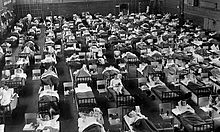1957–1958 Influenza Pandemic

The 1957–1958 Asian flu pandemic was a global pandemic of influenza A virus subtype H2N2 that originated in Guizhou of southern China. The number of deaths caused by the 1957–1958 pandemic is estimated between 1–4 million worldwide, making it one of the deadliest pandemics in history. A decade later, a reassorted viral strain H3N2 further caused the Hong Kong flu pandemic (1968-1969).
History
Origin and outbreak in China
The first cases were reported in Guizhou of southern China, in 1956 or in early 1957. They were soon reported in the neighbouring province of Yunnan in late February or early March 1957. By the middle of March, the flu had spread all over China.
The People's Republic of China was not a member of the World Health Organization at the time (not until 1981), and did not inform other countries about the outbreak. The United States CDC, however, states that the flu was "first reported in Singapore in February 1957".
In late 1957, a second wave of the flu took place in Northern China, especially in rural areas. In the same year, as response to the epidemic, the Chinese government established the Chinese National Influenza Center (CNIC), which soon published a manual on influenza in 1958.
Outbreak in other areas

On 17 April 1957, The Times reported that "an influenza epidemic has affected thousands of Hong Kong residents". By the end of the month (or as early as February), Singapore also experienced an outbreak of the new flu, which peaked in mid-May with 680 deaths, and Singapore was the first country to notify the World Health Organization about an extensive outbreak of the flu which "appeared to have been introduced from Hong Kong". In Taiwan, 100,000 were affected by mid-May, and India suffered a million cases by June. In late June, the pandemic reached the United Kingdom.
By June 1957, it reached the United States, where it initially caused few infections. Some of the first people affected were US Navy personnel at destroyers docked at Newport Naval Station and new military recruits elsewhere. The first wave peaked in October and affected mainly children who recently returned to school after summer break. The second wave, in January and February 1958, was more pronounced among elderly people and so was more fatal.
Vaccine and aftermath
The microbiologist Maurice Hilleman was alarmed by pictures of those affected by the virus in Hong Kong that were published in The New York Times. He obtained samples of the virus from a US Navy doctor in Japan. The Public Health Service released the virus cultures to vaccine manufacturers on 12 May 1957, and a vaccine entered trials at Fort Ord on 26 July and Lowry Air Force Base on 29 July.
The number of deaths peaked the week ending 17 October, with 600 reported in England and Wales. The vaccine was available in the same month in the United Kingdom. Although it was initially available only in limited quantities, its rapid deployment helped contain the pandemic. Hilleman's vaccine is believed to have saved hundreds of thousands of lives.
H2N2 influenza virus continued to be transmitted until 1968, when it transformed via antigenic shift into influenza A virus subtype H3N2, the cause of the 1968 influenza pandemic.
Virology
The strain of virus that caused the Asian flu pandemic, influenza A virus subtype H2N2, was a recombination of avian influenza (probably from geese) and human influenza viruses. As it was a novel strain of the virus, the population had minimal immunity.
Mortality estimates

The World Health Organization estimated the case fatality rate (CFR) of Asian flu to be lower than 0.2%. However, one study found that the CFR was approximately 0.67%. In addition, the disease was estimated to have a 3% rate of complications and 0.3% mortality in the United Kingdom; it could cause pneumonia by itself without the presence of secondary bacterial infection. It may have infected as many as or more people than the 1918 Spanish flu pandemic, but the vaccine, improved health care, and the invention of antibiotics to manage opportunistic bacterial infections contributed to a lower mortality rate.
Estimates of the number of deaths worldwide vary. The World Health Organization and the UK government estimate the death toll to be between one and four million, while a paper published in The Journal of Infectious Diseases estimates 1.1 million. According to the 2016 study in The Journal of Infectious Diseases, the highest excess mortality occurred in Latin America. About 70,000 to 116,000 people died in the United States, and an estimated 33,000 deaths in the United Kingdom were attributed to the 1957–58 flu outbreak. It caused many infections in children, spread in schools, and led to many school closures. However, the virus was rarely fatal in children and was most deadly in pregnant women, the elderly, and those with pre-existing heart and lung disease. In Germany, around 30,000 people died of the flu between September 1957 and April 1958.
Economic effects
The Dow Jones Industrial Average lost 15% of its value in the second half of 1957. In the United Kingdom, the government paid out £10,000,000 in sickness benefit, and some factories and mines had to close. Many schools had to close in Ireland, including seventeen in Dublin.